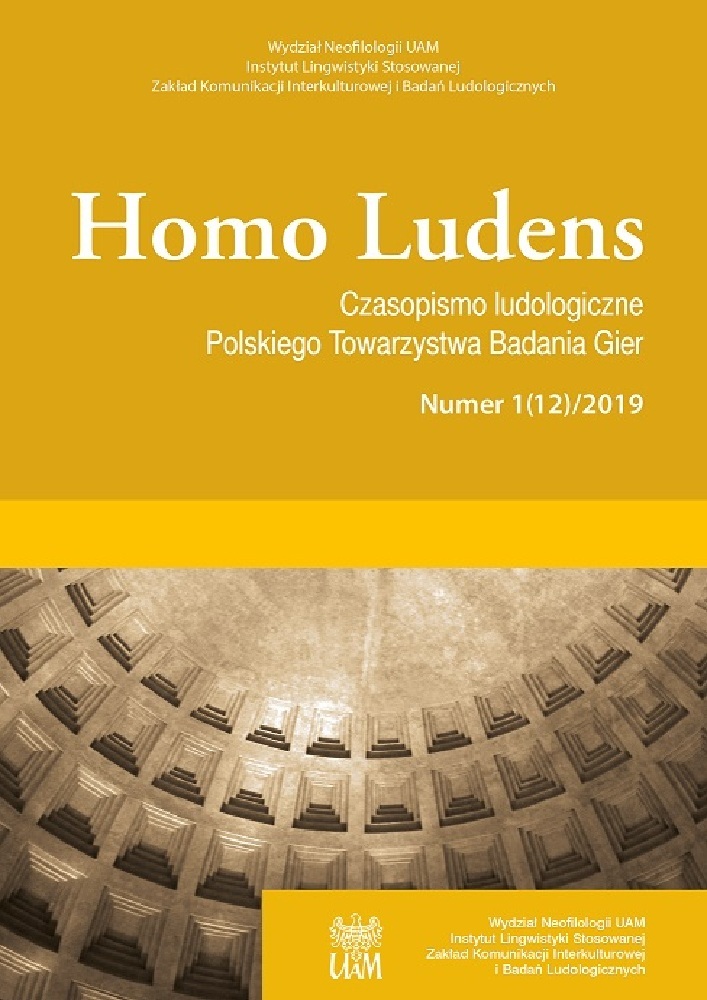Abstract
The aim of the article is to indicate different types of uncertainty in games and to present them in the light of neurophysiological research and selected theories of motivation. The paper analyses: 1) pure randomness (gambling and accidental luck), generated by the system; 2) game complexity; and 3) elements that relate on tactical or strategical level to the human factor. In particular, the application of rules enabling games based on the power of the mind is discussed. The article concludes with the presentation of benefits and disadvantages following the potential implementation of elements inducing uncertainty.
References
Apter, M. J. (1997). Reversal theory: What is it? The Psychologist, 10(5), 212–219.
Arias-Carrión, O., Pŏppel, E. (2007). Dopamine, learning, and rewardseeking behavior. Acta Neurobiologiae Experimentalis, 67(1), 481–488.
Berridge, K. C., Robinson, T. E. (1998). What is the role of dopamine in reward: Hedonic impact, reward learning, or incentive salience? Brain Research Reviews, 28(3), 309–369.
Caillois, R. (2001). Man, Play and Games. Urbana–Chicago: University of Illinois Press.
Calleja, G. (2010). Digital Games and Escapism. Games and Culture, 5(4), 335–353.
Costikyan, G. (2013). Uncertainty in Games. Cambridge, Massachusetts: The MIT Press.
Crawford, Ch. (1982). Design Techniques and Ideas for Computer Games. Byte Magazine, 7(12), 96–108. Online: <http://archive.org/stream/byte-magazine-1982-12/1982_12_BYTE_07-12_Game_Plan_1982#page/n97/mode/2up>. Data dostępu: 31 lipca 2018.
Csikszentmihalyi, M. (2005). Przepływ. Psychologia optymalnego doświadczenia (tłum. M. Wajda-Kacmajor). Taszów: Biblioteka Moderatora.
Czajkowski, M. (2015). Poker – gra szczęścia czy umiejętności? Przegląd analiz teoretycznych i empirycznych oraz wnioski dla regulacji. Ekonomia. Rynek, Gospodarka, Społeczeństwo, 40(1), 33–57.
Fiorillo, C. D., Tobler, P. N., Schultz, W. (2003). Discrete coding of reward probability and uncertainty by dopamine neurons. Science, 299(5614), 1898–1902.
Griffiths, M. D., Dancaster, I. (1995). The effect of type a personality on physiological arousal while playing computer games. Addictive Behaviors, 20(4), 543–548.
Han, D. H., Lee, Y. S., Yang, K. C., Kim, E. Y., Lyoo, I. K., Renshaw, P. F. (2007). Dopamine genes and reward dependence in adolescents with excessive internet video game play. Journal of Addiction Medicine, 1(3), 133–138.
Higgins, E. T. (1987). Self-discrepancy: A theory relating self and affect. Psychological Review, 94(3), 319–340.
Higgins, E. T. (1997). Beyond pleasure and pain. American Psychologist, 52(12), 1280–1300.
Howard-Jones, P. A., Demetriou, S. (2008). Uncertainty and engagement with learning games. Instructional Science, 37(6), 519–536.
Juul, J. (2013). The Art of Failure: An Essay on the Pain of Playing Video Games. Cambridge: MIT Press.
Koepp, M. J., Gunn, R. N., Lawrence, A. D., Cunningham, V. J., Dagher, A., Jones, T., Brooks, D. J., Bench, C. J., Grasby, P. M. (1998). Evidence for striatal dopamine release during a video game. Nature, 393(6682), 266–268.
Mnih, V., Kavukcuoglu, K., Silver, D., Rusu, A. A., Veness, J., Bellemare, M. G., Graves, A., Riedmiller, M., Fidjeland, A. K., Ostrovski, G., Petersen, S., Beattie, Ch., Sadik, A., Antonoglou, I., King, H., Kumaran, D., Wierstra, D., Legg, S., Hassabis, D. (2015). Human-level control through deep reinforcement learning. Nature, 518(7540), 29–533.
Oh, I., Cho, H., Kim, K. (2017). Playing real-time strategy games by imitating human players’ micromanagement skills based on spatial analysis. Expert Systems with Applications, 71(1), 192–205.
Ontanon, S., Synnaeve, G., Uriarte, A., Richoux, F., Churchill, D., Preuss, M. (2013). Survey of real-time strategy game AI research and competition in StarCraft. IEEE Transactions on Computational Intelligence and AI in Games, 5(4), 1–19.
Pecina, S., Cagniard, B., Berridge, K. C., Aldridge, W., Zhuang, X. (2003). Hyperdopaminergic mutant mice have higher „wanting” but not „liking” for sweet rewards. The Journal of Neuroscience, 23(28), 9395–9402.
Quick, J. M., Atkinson, R. K., Lin, L. (2012). Empirical taxonomies of gameplay enjoyment: Personality and video game preference. International Journal of Game-Based Learning, 2(3), 11–31.
Scholla, B. J., Tremouletb, P. D. (2000). Perceptual causality and animacy. Trends in Cognitive Sciences, 4(8), 299–309.
Slezak, D. F., Sigman, M. (2012). Do not fear your opponent: Suboptimal changes of a prevention strategy when facing stronger opponents.
Journal of Experimental Psychology: General, 141(3), 527–538.
Słownik języka polskiego (2019). Blef. Online: <http://sjp.pwn.pl/sjp/blef;2552370.html>. Data dostępu: 26 kwietnia 2019.
Weinstein, A. M. (2010). Computer and video game addiction – a comparison between game users and non-game users. The American Journal of Drug and Alcohol Abuse, 36(5), 268–276.
